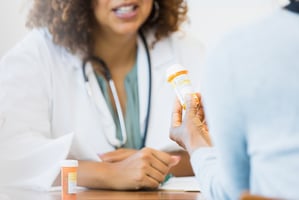Experts Offer Six Steps for Increasing Universal Access to Medication for OUD

Universal access to medications for opioid use disorder (MOUD)—such as methadone, buprenorphine, and naltrexone—could save lives and reduce health care costs, but multiple barriers stand in the way. So wrote Rahul Gupta, M.D., M.P.H., director of the White House Office of National Drug Control Policy, and colleagues in a perspective article appearing in the New England Journal of Medicine (NEJM).
“We believe there are about 8 million above the age of 12 [with opioid use disorder], and less than 5% of those individuals are able to get treatment for opioid use disorder,” Gupta said in an interview with Stephen Morrissey, Ph.D., executive managing editor of the NEJM.
President Joe Biden’s 2022 National Drug Control Strategy (NDCS), which is spearheaded by the Office of National Drug Control Policy, calls for access to MOUD for any person with OUD by 2025. The authors recommended six steps that could assist in meeting this goal:
- Bolster educational opportunities for health professionals: The federal government, along with medical education accreditation bodies, “could bolster addiction-treatment and education infrastructure” by “enhancing content related to MOUD in medical education curricula for all health-related professions and further building workforce capacity in addiction medicine by means of continuing education.”
- Increase access to prescription MOUD in clinic- and community-based programs: One way to increase access to prescription MOUD may be through “low-threshold” buprenorphine treatment (an approach that embraces the harm-reduction philosophy of meeting patients where they are). “Low-threshold treatment programs have shown promise in enrolling people with OUD who may avoid conventional health care settings, where they often face stigma, and whose only point of contact with the health care system might be the emergency department.”
- Ease restrictions on telemedicine: “On the basis of emerging evidence supporting the critical role of telemedicine in increasing access to buprenorphine, the NDCS calls for permanently extending pandemic-era telehealth waivers and flexibility that have permitted the initiation and maintenance of buprenorphine treatment.”
- Increase access to treatment for people who are incarcerated: “Many people who use drugs have frequent interactions with the justice system, and overdose risk in the weeks after release from incarceration is extraordinarily high. … In addition to reducing mortality after release, offering MOUD during incarceration may reduce recidivism.”
- Develop and support programs to address social determinants of health: “Food insecurity, income inequality, discrimination, housing instability, and homelessness have long been recognized as social drivers of population health and can affect retention in MOUD treatment.”
- Take steps to reduce stigma in the health care system against people with OUD: Stigma can reduce the likelihood of initiating and continuing use of MOUD. By using patient-first language (for example, a “person with substance use disorder” rather than an “addict”) and publicizing the benefits of MOUD, clinicians and researchers may be able to help to reduce OUD-related stigma.
Gupta emphasized the role that health care professionals can play in ensuring their patients with OUD have access to MOUD. “The success of the national strategy will ultimately depend on the ability, willingness and the actions by individual providers in communities to act with urgency and make sure that we’re doing the most we can do save lives and get people into treatment,” he said.
For related information, see the Psychiatric News article “Most Youth With OUD Who Need Medication Treatment Do Not Receive It.”
(Image: iStock/SDI Productions)
Don't miss out! To learn about newly posted articles in Psychiatric News, please sign up here.






